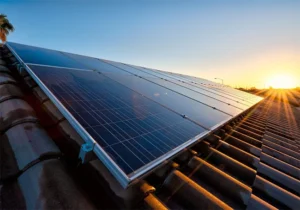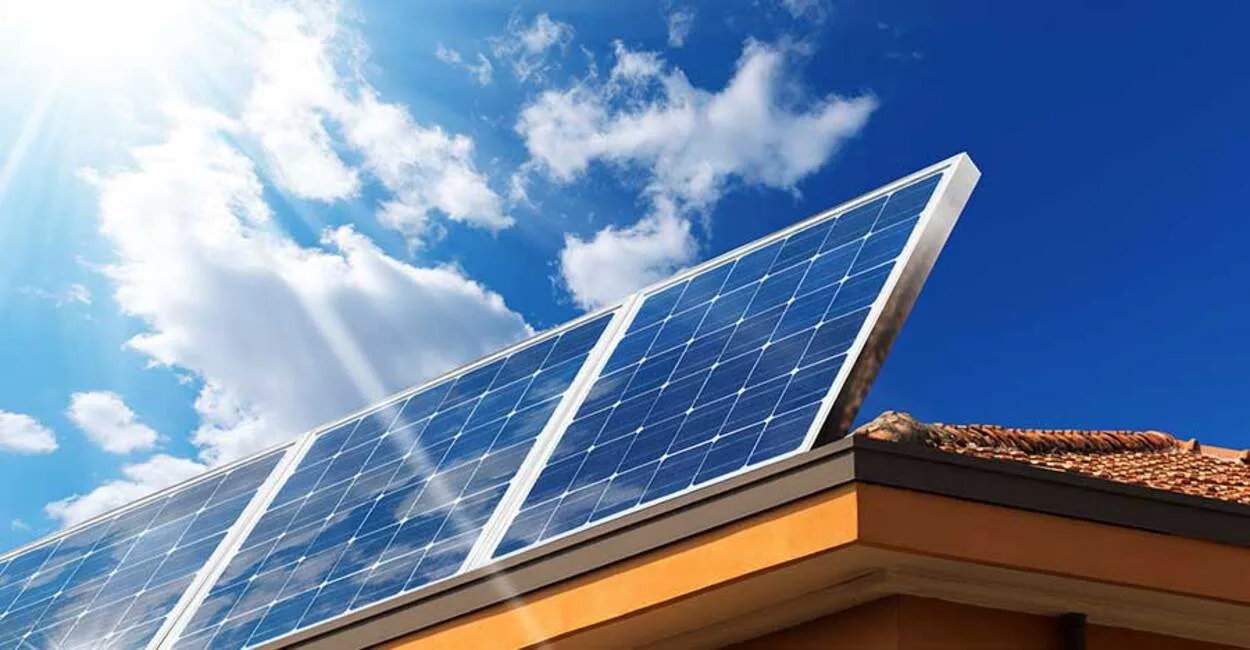Solar panels are a popular choice for those seeking renewable energy solutions. They convert sunlight into electricity, but do solar panels need direct sunlight to function effectively?
This is a common question among homeowners, business owners, and environmental enthusiasts. The answer is not as straightforward as it might seem.
Solar panels can indeed work without direct sunlight. They can generate power even on cloudy days, although their efficiency may be reduced.
The angle and orientation of the panels also play a significant role. They affect the panels’ ability to capture sunlight and convert it into usable energy.
In this article, we will delve deeper into the sunlight requirements for solar panels. We will also provide tips for optimizing their performance. If you’re considering solar energy with a provider like Sunterjee, understanding how solar panels work in different light conditions is crucial.
Understanding Solar Panels and Sunlight Requirements
Solar panels harness the energy of the sun using photovoltaic cells. These cells are the heart of solar panels and are responsible for converting sunlight into electricity.
Do solar panels need direct sunlight to operate at peak efficiency? Not necessarily. Direct sunlight isn’t an absolute requirement for solar panels to operate. They can still generate electricity under indirect or diffused sunlight conditions, thanks to the scattering of solar radiation in the atmosphere.
The efficiency of solar panels depends on several factors, including their angle, orientation, and the materials used in their construction. Positioning panels facing south in the Northern Hemisphere usually maximizes sun exposure and energy production.
It’s essential to understand the local sunlight exposure when installing solar panels. Factors like geographic location and typical weather patterns can significantly influence solar output.
Despite these complexities, the advancement in solar technology has made it possible for panels to generate energy in a variety of sunlight conditions.
How Solar Panels Work with Indirect Sunlight?
Do solar panels need direct sunlight when it’s cloudy or overcast? Not exactly. Solar panels don’t stop working when direct sunlight is absent. Indirect sunlight, often present on cloudy days, still allows solar panels to generate electricity, although at a reduced rate.
Photovoltaic cells in solar panels are designed to capture a broad range of light, including diffused sunlight. This means that even without a clear sky, sunlight scattered by clouds can be harnessed to produce energy.
Different types of solar panels have varying efficiencies when it comes to indirect sunlight. For instance, panels with higher efficiency ratings often perform better in low-light conditions.
This adaptability makes solar panels a viable option even in regions not renowned for constant sunshine. The ability to generate power in diverse conditions is one of the strengths of solar technology.
Innovations in photovoltaic cell technology continue to enhance the ability of solar panels to function well even with indirect sunlight. This makes them more reliable and widely usable.
The Role of Clouds, Rain, and Snow in Solar Energy Production
Weather elements such as clouds, rain, and snow can influence solar energy production. Clouds can significantly diminish direct sunlight, although solar panels still absorb some diffused light.
You might ask again: Do solar panels need direct sunlight to be efficient during bad weather? The answer lies in their ability to adapt. Surprisingly, rain can be beneficial as it helps clean the panels and removes dust and debris that might block sunlight. This self-cleaning aspect can inadvertently boost their efficiency after the rain has passed.
Snow can seem like a more daunting obstacle. However, its impact is usually minimal because panels are often angled, allowing snow to slide off.
For regions with heavy snowfall, it’s essential to clear solar panels to prevent significant energy loss. Fortunately, snow reflects sunlight, potentially increasing the light that reaches the panels.
Overall, solar panels are designed to withstand a variety of weather conditions. They can perform efficiently, adjusting to changes in the environment to continue energy production.
Optimizing Solar Panel Performance
Maximizing the performance of solar panels involves careful planning and regular maintenance. The panels’ positioning and condition significantly impact their efficiency. Ensuring they are free from dirt or obstructions is crucial. Regular cleaning can lead to improved sunlight absorption and energy output.
When considering performance, do solar panels need direct sunlight always? No, but the more sunlight, the better the results. Additionally, selecting the right type of solar panels for your specific climate can make a big difference. Panels with higher efficiency ratings often perform better in low-light conditions, which is important in regions with variable weather.
Implementing a system to monitor solar panel performance is also vital. This helps in identifying drops in efficiency promptly, allowing for swift corrective actions.
Lastly, aligning the investment with geographic and climate conditions maximizes returns. Understanding seasonal and daily sunlight variations helps in predicting and optimizing energy production throughout the year.
Placement and Angle: Maximizing Sunlight Exposure
The placement and angle of solar panels are essential for optimizing sunlight exposure. In the Northern Hemisphere, panels usually perform best when oriented southward. This direction allows for consistent exposure to the sun’s path throughout the day.
Moreover, the angle at which solar panels are installed can have a significant impact. Ideally, they should be tilted to match the latitude of their location, ensuring maximal sunlight capture during peak hours.
Shading is another crucial consideration. Trees, buildings, or other obstructions can reduce the panels’ efficiency by blocking sunlight. Minimizing shade by pruning trees or choosing an unobstructed site is critical.
Adjustments to panel angle throughout the year, to account for the sun’s changing position, can further enhance performance. This might involve tilting panels more steeply in winter and flatter in summer.
Do solar panels need direct sunlight to benefit from good placement? It’s not mandatory, but a well-placed panel will always perform better. Installing panels at the right angle and direction ensures that they harness solar energy most efficiently, optimizing their output across different seasons.

The Impact of Seasonal Changes on Solar Panel Efficiency
Seasonal variations play a role in the efficiency of solar panels. The amount of sunlight changes as the Earth orbits the sun, affecting solar output. In summer, the sun is higher in the sky for longer durations, which can increase energy production.
Conversely, winter months, with shorter days and a lower sun angle, often see reduced solar output. However, panels can still operate effectively by capturing diffused sunlight.
Do solar panels need direct sunlight during every season? Not at all. Even with seasonal changes, panels continue producing energy. Adjusting the tilt of solar panels according to seasons can also maximize energy capture. In winter, steeper angles can compensate for the lower sun position.
Understanding these seasonal patterns helps in predicting energy production and planning accordingly. Despite these changes, solar panels can still deliver significant energy savings year-round. Awareness of these seasonal impacts allows for optimized usage and better planning.
Solar Trackers and Adjustable Tilt Mechanisms
Solar trackers and adjustable tilt mechanisms are innovative solutions to enhance solar panel performance. Trackers follow the sun’s path, positioning panels optimally at all times. This system increases energy capture by maintaining the best angle to the sun throughout the day.
Adjustable tilt mechanisms allow the angle of solar panels to change seasonally. By adjusting the tilt, panels can better align with the sun’s position, maximizing sunlight capture.
Both technologies are invaluable for increasing overall energy yield. While they add an upfront cost, the long-term benefits in energy efficiency can offset this.
These mechanisms provide an effective means to maximize solar panel efficiency, particularly in areas with significant seasonal sunlight variations.
Solar Panel Technologies and Efficiency
Different solar panel technologies offer varying levels of efficiency and sunlight requirements. The choice of technology can greatly influence how well a solar system performs. Traditional monocrystalline panels are known for high efficiency and durability.
Polycrystalline panels, while slightly less efficient, offer cost advantages. Thin-film technology is another option, known for flexibility and better performance in diverse conditions. Each technology has specific advantages, making them suitable for different applications and environments.
Efficiency directly impacts the energy output and the return on investment for solar installations. High-efficiency panels are often preferred in limited space settings. Choosing the right technology involves weighing factors like location, budget, and energy needs.
Researching the latest advancements and comparing options is crucial. This ensures that the chosen solar technology aligns with your goals and conditions.
Advances in Photovoltaic Cell Technology
Recent advances in photovoltaic cell technology are enhancing solar panel performance. Innovations are driving efficiency improvements and cost reductions. Novel materials and designs are helping to capture more sunlight.
Higher efficiency ratings mean better energy production, even in limited sunlight. Technologies like perovskite solar cells show promise with their high efficiency and lower cost. Researchers are continually working to overcome challenges and improve these cutting-edge solutions.
These advancements are making solar energy accessible to more people. Enhanced performance and reduced costs contribute to the widespread adoption of solar power. Continued innovation is crucial for the future of solar energy.
Bifacial Solar Panels: Harnessing Light from All Angles
Bifacial solar panels offer a unique approach to capturing sunlight. These panels generate power from both their front and rear sides. This design increases overall energy yield by harnessing reflected sunlight.
These panels are ideal for maximizing energy production, especially when installed in locations with high albedo surfaces. The additional energy captured can significantly enhance system efficiency.
Bifacial panels are gaining popularity due to their potential for greater energy output. They present a compelling choice for those seeking to optimize their solar investments. As technology advances, bifacial panels continue to improve, offering versatile and efficient solutions.
The Economics of Solar Panels in Various Sunlight Conditions
Investing in solar panels can be financially rewarding, even in areas with less sunlight exposure. The cost of solar installations has decreased, making solar power more accessible. Advances in technology have improved efficiency, providing better returns on investment.
In regions with abundant sunlight, solar panels tend to pay for themselves quickly. However, even with limited sunlight, savings on energy bills can accumulate over time. Local climate and geographical factors play a significant role in financial viability.
Different financing options can help reduce upfront costs for solar panel installations. Leasing and power purchase agreements offer alternatives to traditional buying. These options allow homeowners to benefit from solar power without hefty initial expenses.
Considering the long-term benefits, solar panels often enhance property value. Solar-equipped homes attract eco-conscious buyers seeking lower energy costs. Furthermore, the environmental benefits contribute to reducing your carbon footprint.
Government Incentives and Net Metering Benefits
Government incentives can significantly decrease the costs of going solar. Tax credits, rebates, and grants make solar energy systems more affordable. These programs aim to encourage wider adoption of renewable energy solutions.
Net metering allows solar users to sell excess energy back to the grid. This not only reduces electricity bills but can also generate additional income. The financial benefits of net metering enhance the economic appeal of solar installations.
Incentives and net metering vary by region, so it is crucial to research local policies. Staying informed ensures you maximize potential savings and benefits. These programs are key drivers in the expansion of solar energy use.
Calculating the Payback Period Based on Sunlight Exposure
Understanding the payback period helps assess the financial feasibility of solar panels. This period depends on installation cost, energy savings, and sunlight exposure. More sunlight generally means a faster return on investment.
Accurate calculations consider local weather patterns and energy prices. A professional solar assessment can provide detailed insights for precise estimations. Using simulation tools can also aid in understanding potential energy production.
Reducing the payback period involves optimizing solar panel placement and technology. Ensuring panels receive maximum sunlight extends their economic benefits. These steps ensure that your solar investment meets both financial and environmental goals.
Conclusion
Solar panels offer numerous benefits even without constant direct sunlight. Advances in technology ensure efficiency across varied conditions.
Embracing solar energy is a practical step towards sustainability. Whether the sun shines brightly or behind clouds, solar power remains a viable choice for clean energy.

Sneha Shah is the owner and driving force behind transformative solar solutions for homes and businesses. With 15+ years in biotech and a strong foundation in project management and sustainability, she bridges technical expertise with market insight. Sneha is also a mentor and clean energy advocate, passionate about expanding solar access to underserved communities.

